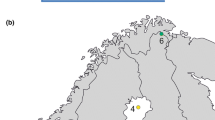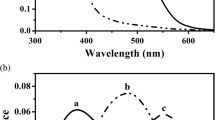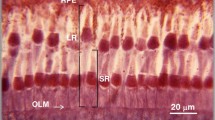Summary
Microspectrophotometric examination of individual rods, and partial bleaching of visual pigment extracts from three species of deep-sea fish,Aristostomias grimaldii, Malacosteus niger andPachystomias microdon, suggest the presence of a rhodopsin-porphyropsin system of paired pigments.Aristostomias andMalacosteus have a P5522-P5171 pair, whilePachystomias has a P5442-P5131 pair. In contrast to most pigmentpair systems, each pigment is restricted to a single class of rod, thus giving the fish two spectrally distinct classes of photoreceptor. It is suggested that the longwave sensitive rods are an adaptation enabling these species to perceive their own deep-red bioluminescence. The astaxanthin-based red tapetum inMalacosteus, and a chlorin-like pigment, possibly acting as a photosensitizer and found in the rod outer segments ofMalacosteus, may also act to increase longwave sensitivity.
Similar content being viewed by others
References
Allen DM (1971) Photic control of the proportion of two visual pigments in a fish. Vision Res 11:1077–1112
Avery JA, Bowmaker JK (1982) Visual pigments in the four-eyed fish,Anableps anableps. Nature 298:62–63
Baker A de C, Clarke MR, Harris MJ (1973) The N.I.O. combination net (RMT 1+8) and further developments of rectangular midwater trawls. J Mar Biol Assoc UK 53:167–184
Barlow HB (1982) What causes trichromacy A theoretical analysis using comb-filtered spectra. Vision Res 22:635–643
Bridges CDB (1965) The grouping of visual pigments about preferred positions in the spectrum. Vision Res 5:223–238
Bridges CDB (1972) The rhodopsin-porphyropsin visual system. In: Dartnall HJA (ed) Photochemistry of vision (Handbook of sensory physiology, vol VII/1) Springer, Berlin Heidelberg New York, pp 417–480
Clarke GL (1936) On the depth at which animals can see. Ecology 17:452–456
Dartnall HJA, Lythgoe JN (1965) The spectral clustering of visual pigments. Vision Res 5:81–100
Dartnall HJA, Bowmaker JK, Mollon JD (1983) Human visual pigments: microspectrophotometric results from the eyes of seven persons. Proc R Soc Lond B 220:115–130
Denton EJ, Herring PJ (1971) Report of the Council. J Mar Biol Assoc UK 51:1035
Denton EJ, Gilpin-Brown JB, Wright PG (1970) On the ‘filters’ in the photophores of mesopelagic fish and on a fish emitting red light and especially sensitive to red light. J Physiol 208:72P-73P
Denton EJ, Herring PJ, Widder EA, Latz MF, Case JF (1985) The roles of filters in the photophores of oceanic animals and their relation to vision in the oceanic environment. Proc R Soc Lond B 225:63–97
Downing JEG, Djamgoz MBA, Bowmaker JK (1986) Photoreceptors of a cyprinid fish, the roach: morphological and spectral characteristics. J Comp Physiol A 159:859–868
Freeman CP, West D (1966) Complete separation of lipid classes on a single thin layer plate. J Lipid Res 7:324–327
Gibbs RH (1984) Melanostomiidae and Malacosteidae. In: Whitehead PJP, Bauchot M-L, Hureau J-C, Nielson J, Tortonese E (eds) Fishes of the North Atlantic and Mediterranean, vol 1. UNESCO, Paris, pp 341–370
Herring PJ (1973) Depth distribution of the carotenoid pigments and lipids of some oceanic animals. 2. Decapod crustaceans. J Mar Biol Assoc UK 53:539–562
Herring PJ (1983) The spectral characteristics of luminous marine organisms. Proc R Soc Lond B 220:183–217
Jerlov NG (1968) Optical oceanography. Elsevier, Amsterdam
Kalt MR, Tandler B (1971) A study of fixation of early amphibian embryos for electron microscopy. J Ultrastruct Res 36:633–645
Knowles A, Dartnall HJA (1977) The photobiology of vision. In: Davson H (ed) The eye, vol 2 B. Academic Press, London New York
Lockett NA (1977) Adaptations to the deep-sea environment. In: Crescitelli F (ed) (Handbook of sensory physiology, vol VII/5). Springer, Berlin Heidelberg New York, pp 67–192
Loew ER, Dartnall HJA (1976) Vitamin A1/A2-based visual pigment mixtures in cones of the rudd. Vision Res 16:891–896
Lythgoe JN (1972) The ecology of vision. Clarendon, Oxford
MacNichol EF, Kunz YW, Levine JS, Harosi FI, Collins BA (1983) Ellipsosomes: organelles containing a cytochromelike pigment in the retinal cones of certain fishes. Science 200:549–551
Mollon JD, Bowmaker JK, Jacobs GH (1984) Variations in colour vision in a New World primate can be explained by polymorphism of retinal photopigments. Proc R Soc Lond B 222:373–399
O'Day WT, Fernandez HR (1974)Aristostomias scintillans (Malacosteidae): a deep-sea fish with visual pigments apparently adapted to its own bioluminescence. Vision Res 14:545–550
Partridge JC, Archer SN, Lythgoe JN (1988) Visual pigments in the individual rods of deep sea fishes. J Comp Physiol A 162:543–550
Schwanzara SA (1967) The visual pigments of freshwater fishes. Vision Res 7:121–148
Spikes JD (1977) Photosensitization. In: Smith KC (ed) The science of photobiology. Plenum, New York
Somiya H (1982) ‘Yellow lens’ eyes of the stomiatoid deep sea fish,Malacosteus niger. Proc R Soc Lond B 215:481–489
Vernon LP (1960) Spectrophotometric determinations of chlorophylls and pheophytins in plant extracts. Anal Chem 32:1144–1150
Widder EA, Latz MF, Herring PJ, Case JF (1984) Far-red bioluminescence from two deep-sea fishes. Science 225:512–514
Wyszecki G, Stiles WS (1982) Colour science. Wiley, New York
Author information
Authors and Affiliations
Rights and permissions
About this article
Cite this article
Bowmaker, J.K., Dartnall, H.J.A. & Herring, P.J. Longwave-sensitive visual pigments in some deep-sea fishes: segregation of ‘paired’ rhodopsins and porphyropsins. J. Comp. Physiol. 163, 685–698 (1988). https://doi.org/10.1007/BF00603853
Accepted:
Issue Date:
DOI: https://doi.org/10.1007/BF00603853




